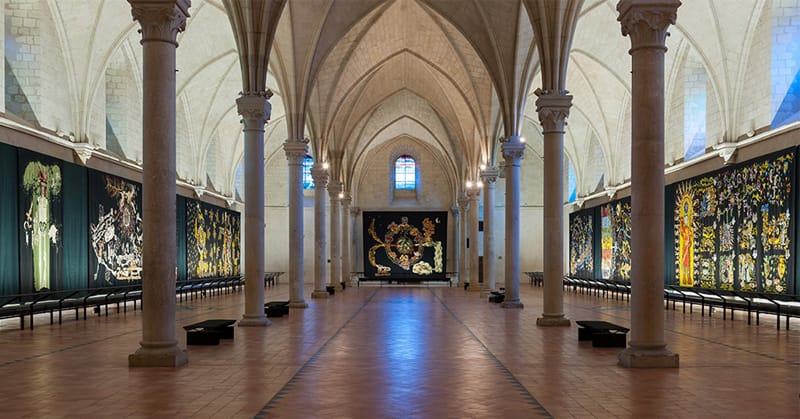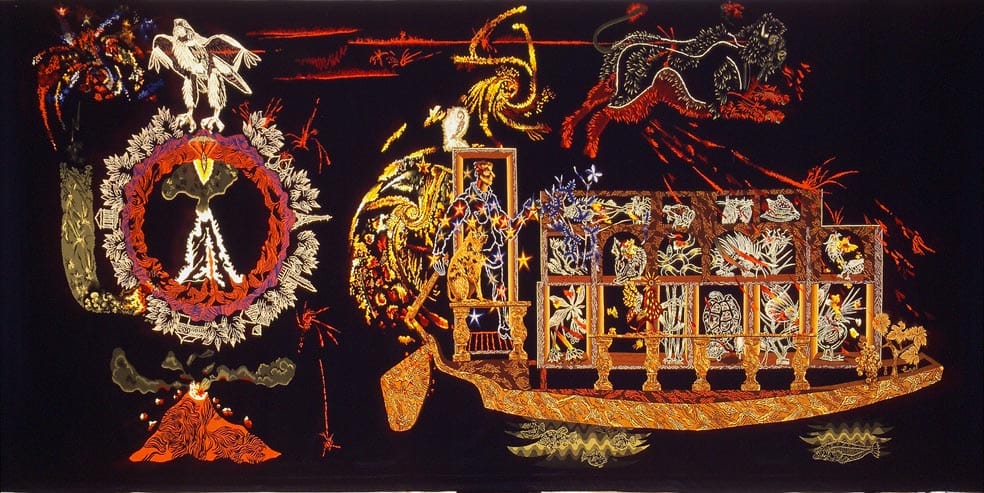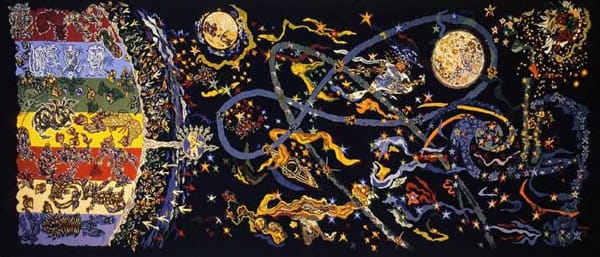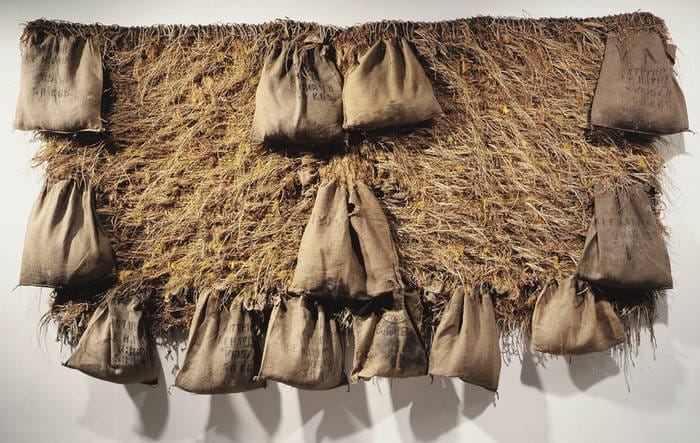INTERNATIONAL MINI-TEXTILE COMPETITION, Angers Museums (Jean-Lurçat and the Museum of Contemporary Tapestry)
COMPETITION
The city of Angers consolidates its position as the city of tapestries and textiles by organizing for the ninth time, since 1993, an international competition of mini-fabrics at the Jean-Lurçat and Contemporary Tapestry Museum, created in 1986 and filled with over 500 textile works acquired in 30 years.
The theme of this edition is: Measure / Excess. The aim of this competition is to stimulate research, creation and innovation in the field of contemporary textile art. This international competition is open to all artists.
After the selection of the works by a jury of professionals, an exhibition will be organized from July 3, 2021 January 9, 2022 at the Jean-Lurçat and Contemporary Tapestry Museum.
To participate, download the documents HERE
and send the files by Monday November 23, 2020 to the following address:
Direction des musées d’Angers
Concours international des mini-textiles
À l’attention de Béatrice Dupré
14 rue du musée
49100 Angers
JEAN-LURÇAT AND THE MUSEUM OF CONTEMPORARY TAPESTRIES
“The Song of the World” by Jean Lurçat
Statement of a committed artist, this set of ten tapestries constitutes an epic, poetic, symbolic and humanist vision of the 20th century.
Le Chant du Monde by Jean Lurçat has been on display in the large sick room of the Saint Jean hospital since 1968. It has replaced the collections of the archaeological museum presented in this space since 1874.
On display are ten monumental tapestries (347 m²) homage to the medieval tapestry of the Apocalypse, displayed at the Château d’Angers. Jean Lurçat (1892-1966) discovered this masterpiece in 1937 and this “meeting” had a decisive influence on his artistic activity. In 1957 he had the ten pieces of his Chant du Monde weave in Aubusson. With these works the artist wants to express the final victory of man who lives in harmony with the world and the elements. The work was supposed to continue but was interrupted by the death of Jean Lurçat in 1966.
THREE GREAT FIGURES OF THE CONTEMPORARY TAPESTRY
JEAN LURÇAT
(Bruyères, 1892 – Saint-Paul de Vence, 1966)
Jean Lurçat’s artistic career is witnessed in the rooms of the Museum of Contemporary Tapestry, with the exhibition of his paintings and in particular the deepening of surrealism and cubism, arriving at his interest in tapestries. Jean Lurçat is one of the main protagonists of the postwar “French Tapestry Renaissance” movement.
He develops various techniques that allow the correct transcription of the cards to the workshop in charge of the execution of the works, exploiting his knowledge and his studies of medieval tapestries.
LA GRANDE MENACE, Jean Lurçat, 1957, 440×900 cm, Atelier Tabard, Aubusson
First tapestry of “Chant du monde” (1957-1966), purchased by Simone Lurçat, 1967. Copyright Musei di Angers
CONQUÊTE DE L’ESPACE, Jean Lurçat, 1960, 440 x 1035 cm, Atelier Tabard, Aubusson Huitième tapisserie du Chant du monde (1957-1966), Achat S.Lurçat , 1967. Copyright Musei di Angers
LIBERTÉ, Jean Lurçat, Cardboard 1943, weaving 1952, 2,83 x 3,64 m
atelier Picaud, Aubusson, Donation Simone Lurçat, 1988. Copyright Musei di Angers
THOMAS GLEB
(Lods, 1912 – Angers, 1991)
In 1965 Pierre Carton, who ran the tapestry workshop at the Ecole des Beaux-Arts, offered his students to weave Gleb’s patterns. In 1968 Angers’ first tapestry workshop, the ATA, began a fruitful collaboration with Gleb and in 1987, a major Thomas Gleb exhibition was organized at the Jean Lurçat and Contemporary Tapestry Museum. Thomas and Maria chose to settle in Angers in 1989. With the exhibition La tapisserie patrie by Thomas Gleb room Chemellier in 1990 in Angers 24 tapestries and 11 sculptures were donated to the museum. A permanent room dedicated to Gleb was opened in 1991, the year of the artist’s death.
From 1992 to 2004 several donations of Gleb’s works were made to the museum, including poems, drawings and archives, studied and then classified by a team of researchers who were exhibited in 2001 in a large exhibition at the museum – “Gleb new faces” – , on the multiple aspects of Gleb’s creative personality: painting, sculpture, architecture, writings, tapestries …
In 2004 three permanent spaces were reserved for the presentation of Thomas Gleb’s works at the contemporary tapestry museum. Among the major works we can mention Shabatt or The Tables of the Law.
In 2012, the exhibition “Sacré Blanc! Hommage à Thomas Gleb” at the Jean-Lurçat and Contemporary Tapestry Museum, proposed to compare the work of Gleb and the creations of about fifty contemporary artists on the white and sacred theme.
LES TABLES DE LA LOI, Thomas Gleb, 1968-1969, 225 x 364 cm
Unique copy, Saint-Cyr workshop (Pierre Daquin), Donation Gleb, Angers 1990. Copyright Musei di Angers
JOSEP GRAU-GARRIGA
(Sant Cugat del Valles, 1929 – Saint-Mathurin sur Loire, 2011
Grau-Garriga, a Catalan artist, settled on the banks of the Loire in Saint Mathurin, shortly after 1989, the date of his Angevin exhibitions (on the occasion of the commemoration of the bicentenary of the French Revolution)
In a large painting workshop, a barn-workshop of tapestries, with the proximity of the Loire and its magnificent lights, and his family begins a particularly fruitful and creative period for the artist.
The life of the peasants, the memories of his childhood, landscapes inspire his tapestries. The proximity to Angers favors the project of the exhibition on his works of the decade 1990/2000
In 2002 the Jean-Lurçat and the Museum of Contemporary Tapestries exhibited his latest woven creations, the Ronceay Abbey his paintings on religious subjects, the Chemellier room his painted portraits. At the same time, the Beaufort-en-Vallée museum opens its doors to him for an “in situ” creation.
A monograph is published by the “Cercle d’art” editions with the collaboration of Gilbert Lascault for the texts.
Grau-Garriga donated to the city four monumental tapestries and two drawings belonging to the cycle of works on the artist’s childhood in Catalonia, country life (“Aspre-dolc”, “Amb o sense fruit”), a tribute to his parents (“To the father” and “To the mother”) and to the couple (“Home” and “Dona”).
In 2010 shortly before his death, his historical role was highlighted in an exhibition on the Catalan tapestry at the Jean-Lurçat museum and contemporary tapestry.
The same year, the artist agreed to create a stained glass window topped with painted and woven panels for the second internal entrance door to the church of Saint Mathurin sur Loire. He had chosen for this work the theme of peace and openness to the world
DIPTYQUE AL MADRE – AL PADRE, Josep Grau-Garriga, 2001 – 2002, Raphia, chanvre 4,50x2m. Donation Josep Grau-Garriga. Copyright Musei di Angers
AMB O SENSE FRUIT, AVEC OU SANS RÉCOLTE, Josep Grau-Garriga, 2001, 240 x 450 cm, Artist’s studio, Saint-Mathurin-sur-Loire, Raffia, wool, sisal, cotton, jute bags, silk. Copyright Musei di Angers
THE COLLECTIONS
The six rooms house about sixty tapestries organized to create a chronological journey that traces the historical evolution of the tapestry around the three great characters who are Jean Lurçat. (1892-1966), Thomas Gleb (1912-1991) and Josep Grau-Garriga (1929-2011).
The visitor can thus grasp the origins of the ties established with Jean Lurçat and Thomas Gleb, the artistic influences, the filiations but also the plural evolutions of the tapestry, of the different periods, historical, geographical areas and stylistic schools.
THE SIX-PART COLLECTION
Room 1: Lurçat, the years of youth: 1919-1936
Small passage: Lurçat and ceramics, the 1950s
Room 2: The tapestries of the war, the 1940s
Room 3: The APCT (the Association of tapestry), the 1950s
Room 4: Thomas Gleb, the woven interpretation, the 1960s
Room 5: The “New Tapestry”, the 1970s
Room 6: Josep Grau-Garriga, donation 2004








